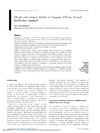Please use this identifier to cite or link to this item:
https://accedacris.ulpgc.es/jspui/handle/10553/44865
| DC Field | Value | Language |
|---|---|---|
| dc.contributor.author | Serra-Majem, L. | en_US |
| dc.date.accessioned | 2018-11-22T03:11:27Z | - |
| dc.date.available | 2018-11-22T03:11:27Z | - |
| dc.date.issued | 2001 | en_US |
| dc.identifier.issn | 1368-9800 | en_US |
| dc.identifier.uri | https://accedacris.ulpgc.es/handle/10553/44865 | - |
| dc.description.abstract | Objective: To provide an overview of vitamin and mineral intakes among children and adolescents in European countries and to present results from studies showing the impact of food fortification. Design: Comparative analysis of a number of nutritional studies among children and adolescents performed during the last decade in certain European countries. Setting: Spain, France, UK, North Ireland, Portugal, Germany. Subjects: Europeans aged 6 to 18. Results: Dietary surveys across Europe showed that varying levels of nutrient adequacy existed from one country to another, and that even within the same country, there were important nutritional gaps between different regions. In general, studies are difficult to compare, and information for many countries was missing. The results suggest that children and adolescents are the population group most likely to have higher risk of nutritional deficiencies, particularly for iron, vitamins C, E, B6 and folates. In France, Ireland, UK and Spain, food fortification, and particularly of breakfast cereals, has positively contributed to increasing vitamin and mineral intakes in childhood and adolescence. Conclusions: Information on vitamin and mineral intakes in European children is less available than in adults. Fortified foods may contribute to reducing nutrient inadequacy in European children and adolescents, but should not replace nutrition education. | en_US |
| dc.language | eng | en_US |
| dc.relation.ispartof | Public Health Nutrition | en_US |
| dc.source | Public Health Nutrition [ISSN 1368-9800], v. 4, p. 101-107 | en_US |
| dc.subject | 32 Ciencias médicas | en_US |
| dc.subject | 3206 Ciencias de la nutrición | en_US |
| dc.subject.other | Children | en_US |
| dc.subject.other | Adolescent | en_US |
| dc.subject.other | Dietary intake | en_US |
| dc.subject.other | Nutrition education | en_US |
| dc.subject.other | Food fortification | en_US |
| dc.subject.other | Europe | en_US |
| dc.title | Vitamin and mineral intakes in European children. Is food fortification needed? | en_US |
| dc.type | info:eu-repo/semantics/review | en_US |
| dc.type | Article | en_US |
| dc.identifier.doi | 10.1079/PHN2000104 | - |
| dc.identifier.scopus | 0035079054 | - |
| dc.contributor.authorscopusid | 35596972100 | - |
| dc.description.lastpage | 107 | en_US |
| dc.description.firstpage | 101 | en_US |
| dc.relation.volume | 4 | en_US |
| dc.investigacion | Ciencias de la Salud | en_US |
| dc.type2 | Reseña | en_US |
| dc.description.numberofpages | 8 | en_US |
| dc.utils.revision | Sí | en_US |
| dc.date.coverdate | Enero 2001 | en_US |
| dc.identifier.ulpgc | Sí | en_US |
| dc.contributor.buulpgc | BU-MED | en_US |
| dc.description.scie | SCIE | |
| item.fulltext | Con texto completo | - |
| item.grantfulltext | open | - |
| crisitem.author.dept | GIR IUIBS: Nutrición | - |
| crisitem.author.dept | IU de Investigaciones Biomédicas y Sanitarias | - |
| crisitem.author.dept | Departamento de Ciencias Clínicas | - |
| crisitem.author.orcid | 0000-0002-9658-9061 | - |
| crisitem.author.parentorg | IU de Investigaciones Biomédicas y Sanitarias | - |
| crisitem.author.fullName | Serra Majem, Luis | - |
| Appears in Collections: | Reseña | |
SCOPUSTM
Citations
59
checked on Jun 8, 2025
Page view(s)
79
checked on Jan 11, 2025
Download(s)
178
checked on Jan 11, 2025
Google ScholarTM
Check
Altmetric
Share
Export metadata
Items in accedaCRIS are protected by copyright, with all rights reserved, unless otherwise indicated.
